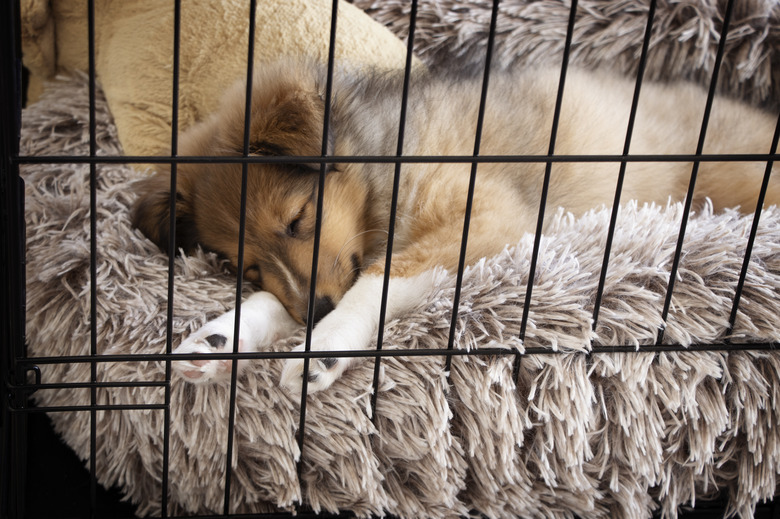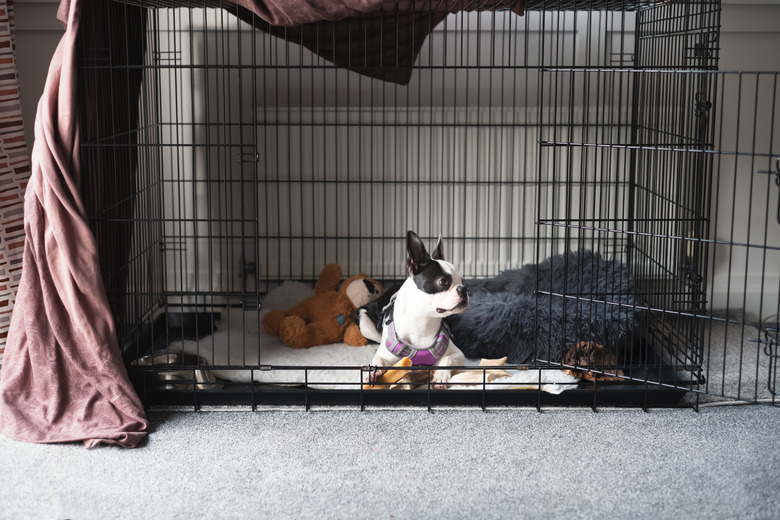Should You Cover A Dog Crate?
Your dog's crate provides him with a safe haven and a spot to relax when he wants to snooze or simply wind down after a long day of playing fetch and walking in the park. Whether or not you should cover that crate depends on the situation and your dog's reaction when placed inside an enclosed space. It also depends on whether your dog's crate is an open mesh style that might require a cover.
Although it's best to cover your dog's crate at bedtime to encourage restful sleep or during a car ride to prevent motion sickness, not all dogs like a covered crate. Let your dog's reaction and some gentle crate training decide whether it's time to cover the crate. If he doesn't become anxious, then feel free to use the crate cover when you feel it's necessary.
Quiet dog crate sanctuary
Quiet dog crate sanctuary
While a fully enclosed wood or plastic crate may not require a cover, an open, mesh-style crate or thin, cloth crate for dogs will need a fabric cover. Once you've fully crate trained your dog, you can cover her crate at night to encourage her to sleep soundly without waking throughout the entire night.
Covering your dog's crate also helps reduce barking and whining during the night, ensuring quiet time for you and your dog. There are even specialized crate covers that are made for use with dog crates, or you can use a blanket, sheet, or throw.
Think of putting a cover on your dog's crate like tucking her in at night, pulling the curtains closed, and signaling that it's quiet time. It keeps out light and other visual stimuli and indicates to your dog that it's time to start winding down and relaxing. If your dog is calm and seems happy when the crate is covered, then you can continue this routine to let her know that it's bedtime each night.
Covering the crate while driving
Covering the crate while driving
Some dogs love watching the world whizz by while on a car trip with their owners, while others experience motion sickness. If your dog falls into the latter category, a good way to combat motion sickness is to cover your dog's crate while the car is moving.
The reason why covering your dog's crate in the car is a good idea is because it keeps your dog from seeing the car's movement. Watching other cars and objects move by so quickly from the window can lead to motion sickness. A dark fabric cover will prevent this from happening but only if your dog is crate trained and doesn't become anxious in the crate.
How to hide a dog crate
How to hide a dog crate
Mesh metal dog crates can appear unattractive to the human eye and may not blend well with your decor. That's another reason to cover your dog crate because it hides the unattractive mesh. Be sure to pick a lightweight one that only covers three sides and allows for proper airflow within the crate.
While some dogs don't mind having their crate covered at all times with fabric, others may become anxious if they don't see their owners even while in their crate. In these instances, it might be better to cover only part of the crate, place the crate under a table, or put it next to a couch where it is less visible but still part of your most-used living space.
When to avoid the cover
When to avoid the cover
Some dogs, even those who are fully crate trained, become anxious when their crate is covered. To help prevent anxiety when crated, try giving your dog a puzzle toy filled with her favorite treats just before you cover the crate. Leave the cover on for 10 to 20 minutes and then remove it. Do this daily, gradually extending the time you leave the crate covered.
If your dog attempts to pull the cover inside the crate and eat it, then it's best to avoid covering the crate. This could indicate a condition called pica in which dogs eat nonfood items. Your veterinarian can help with this.
References
- American Society For the Prevention of Cruelty to Animals: Separation Anxiety
- Animal Rescue & Foster Program: Crate Training
- Royal Society For the Prevention of Cruelty to Animals Victoria: Crate Training Your Dog
- Hepper: Should You Cover Your Dog's Crate? (The Quick Answer)
- Orvis: Should You Cover Your Dog's Crate?
- Dogs Naturally Magazine: Dog Car Sickness: Natural Remedies That Work
- Best Friends Animal Society: Pica in Dogs: Causes, Diagnosis and Treatment

